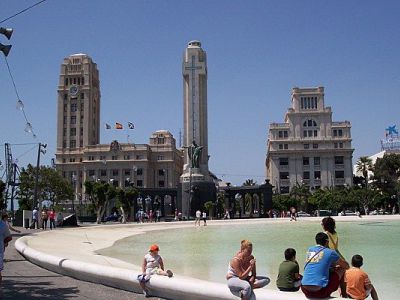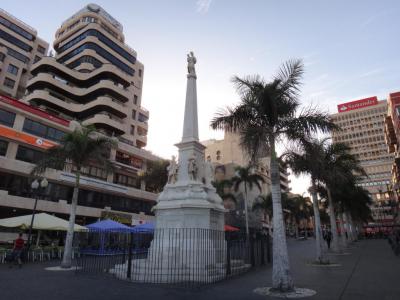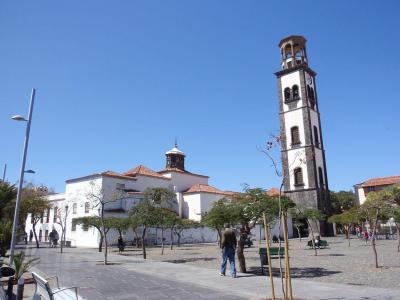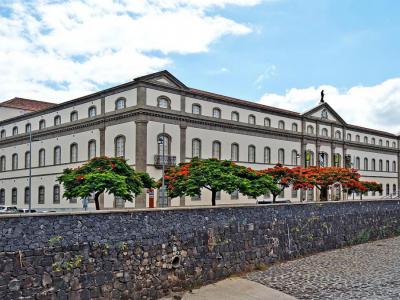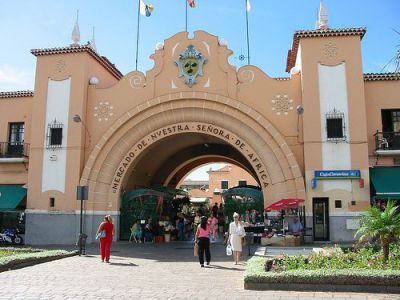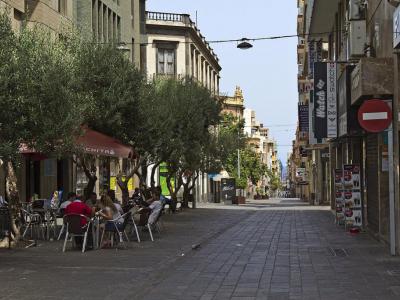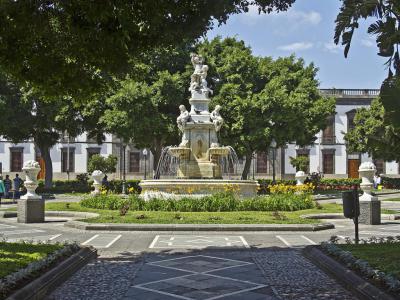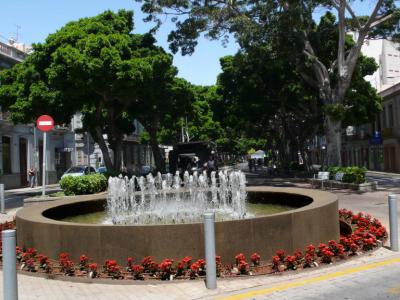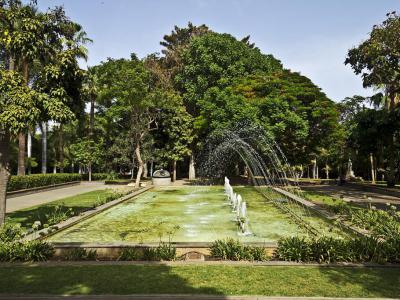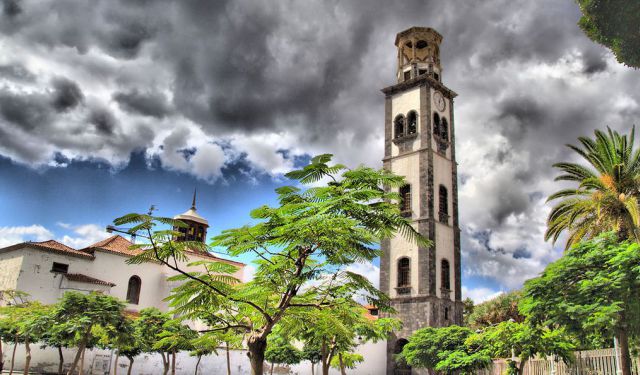Santa Cruz de Tenerife Introduction Walking Tour (Self Guided), Santa Cruz de Tenerife
There is archeological evidence indicating a civilization two thousand years ago in the area where Santa Cruz stands today. The indigenous people were the Guanches. The island of Tenerife was called Anazo. The famous Mummy of San Andres is an excellent silent witness to those long-ago times. Before the Spaniards there were kingdoms.
On the third of May in 1494, Castilian soldiers commanded by Alonso Fernandez de Lugo, an ambitious conquistador, set foot on the island. He made his camp and planted his cross in the place that would become Santa Cruz and he set about destroying the kingdoms of Anaga.
Tenerife was strategically located on the routes between Southern Europe and the Americas. It was attacked several times by envious maritime powers. In 1656 British Admiral Robert Blake made off with the silver. British came again, John Jennings lost a battle in 1706 and Lord Nelson lost an arm in 1797.
In the 21st century Santa Cruz has experienced strong economic and architectural development. Around the port area urban boulevards and broad avenues are marked with modernist and neoclassical architecture, monuments and squares. In the center of the city the Spain Square is built over San Cristobal Castle.
The Auditorium of Tenerife, built in 2003, is shaped like sails. The Towers of Santa Cruz, finished in 2006, are the tallest skyscrapers in the Canaries. Tenerife Space of Arts, designed by native architect Virgillo Gerreros, houses the museum Dominguez Institute. The Garcia Sanabria Park covers 800,000 square feet of gardens, fountains and sculptures.
Speaking of islands, one must visit the beach called Teresitas Beach (Playa de las Teresitas), the most impressive beach of the Canary Islands. There are at least 14 festivals throughout the year. There are festivals for Classical music, opera, blues, film, Carnival, Cross Day, Salsa festival and one must not forget the Tenerife Zombie Walk.
There are twelve prominent churches and one Masonic Temple, pedestrianized shopping streets and squares. The festivals and Carnival of Tenerife are declared to be the most spectacular in Spain. It cost Lord Nelson an arm to visit Tenerife but that was long before the fabulous days of tourism now. So, come, visit and enjoy!
On the third of May in 1494, Castilian soldiers commanded by Alonso Fernandez de Lugo, an ambitious conquistador, set foot on the island. He made his camp and planted his cross in the place that would become Santa Cruz and he set about destroying the kingdoms of Anaga.
Tenerife was strategically located on the routes between Southern Europe and the Americas. It was attacked several times by envious maritime powers. In 1656 British Admiral Robert Blake made off with the silver. British came again, John Jennings lost a battle in 1706 and Lord Nelson lost an arm in 1797.
In the 21st century Santa Cruz has experienced strong economic and architectural development. Around the port area urban boulevards and broad avenues are marked with modernist and neoclassical architecture, monuments and squares. In the center of the city the Spain Square is built over San Cristobal Castle.
The Auditorium of Tenerife, built in 2003, is shaped like sails. The Towers of Santa Cruz, finished in 2006, are the tallest skyscrapers in the Canaries. Tenerife Space of Arts, designed by native architect Virgillo Gerreros, houses the museum Dominguez Institute. The Garcia Sanabria Park covers 800,000 square feet of gardens, fountains and sculptures.
Speaking of islands, one must visit the beach called Teresitas Beach (Playa de las Teresitas), the most impressive beach of the Canary Islands. There are at least 14 festivals throughout the year. There are festivals for Classical music, opera, blues, film, Carnival, Cross Day, Salsa festival and one must not forget the Tenerife Zombie Walk.
There are twelve prominent churches and one Masonic Temple, pedestrianized shopping streets and squares. The festivals and Carnival of Tenerife are declared to be the most spectacular in Spain. It cost Lord Nelson an arm to visit Tenerife but that was long before the fabulous days of tourism now. So, come, visit and enjoy!
How it works: Download the app "GPSmyCity: Walks in 1K+ Cities" from Apple App Store or Google Play Store to your mobile phone or tablet. The app turns your mobile device into a personal tour guide and its built-in GPS navigation functions guide you from one tour stop to next. The app works offline, so no data plan is needed when traveling abroad.
Santa Cruz de Tenerife Introduction Walking Tour Map
Guide Name: Santa Cruz de Tenerife Introduction Walking Tour
Guide Location: Spain » Santa Cruz de Tenerife (See other walking tours in Santa Cruz de Tenerife)
Guide Type: Self-guided Walking Tour (Sightseeing)
# of Attractions: 9
Tour Duration: 2 Hour(s)
Travel Distance: 3.3 Km or 2.1 Miles
Author: Sandra
Sight(s) Featured in This Guide:
Guide Location: Spain » Santa Cruz de Tenerife (See other walking tours in Santa Cruz de Tenerife)
Guide Type: Self-guided Walking Tour (Sightseeing)
# of Attractions: 9
Tour Duration: 2 Hour(s)
Travel Distance: 3.3 Km or 2.1 Miles
Author: Sandra
Sight(s) Featured in This Guide:
- Plaza de España (Spain Square)
- Plaza de la Candelaria (Candelaria Square)
- Parroquia de la Concepcion (Church of Immaculate Conception)
- Museo de la Naturaleza y Arqueologia (Museum of Nature and Archaeology)
- Mercado Nuestra Señora de Africa (Market of Our Lady of Africa)
- Calle del Castillo (Castle Street)
- Plaza Weyler & Fuente (Weyler Square and Fountain)
- Rambla de Santa Cruz (Santa Cruz Avenue)
- Parque García Sanabria (García Sanabria Park)
1) Plaza de España (Spain Square) (must see)
On July 25, 1797, British Rear Admiral Horatio Nelson lost his right arm to a musket ball fired from the Tiger Cannon of the Castle of San Cristobal in the Battle of Santa Cruz de Tenerife. The Admiral had attempted an amphibious landing to take the town. He lost the battle and his arm.
The Spain Square was laid down over the Castle of San Cristobal in 1929. Remains of the castle walls are on display in a tunnel under the square. The notorious Tiger Cannon is also there, looking fine after all these years. The square is located in the center of town. It is one of the main squares of the island of Tenerife.
The square is the work of architects Jacques Herzog and Pierre de Meuron of Herzog & Meuron of Switzerland. The Plaza has a lake and a fountain. Around the square is the Insular Palace of Tenerife, the Palace of the Charter and the Candelaria Square. The Monument to the Fallen of the Spanish Civil War is in the center of the square.
A sign, reading "Santa Cruz" (short for the slogan "Sant Cruz, the heart of Tenerife") is at one end of the square. The last letter of the word "Santa" is in the form of two hearts, one green, one blue. A sculpture "I AM Fine (Lo Llevo bien)" by Basque artist Julio Nieto is next to the lake. It is a man in the shape of a tree, a symbol of optimism.
The Spain Square was laid down over the Castle of San Cristobal in 1929. Remains of the castle walls are on display in a tunnel under the square. The notorious Tiger Cannon is also there, looking fine after all these years. The square is located in the center of town. It is one of the main squares of the island of Tenerife.
The square is the work of architects Jacques Herzog and Pierre de Meuron of Herzog & Meuron of Switzerland. The Plaza has a lake and a fountain. Around the square is the Insular Palace of Tenerife, the Palace of the Charter and the Candelaria Square. The Monument to the Fallen of the Spanish Civil War is in the center of the square.
A sign, reading "Santa Cruz" (short for the slogan "Sant Cruz, the heart of Tenerife") is at one end of the square. The last letter of the word "Santa" is in the form of two hearts, one green, one blue. A sculpture "I AM Fine (Lo Llevo bien)" by Basque artist Julio Nieto is next to the lake. It is a man in the shape of a tree, a symbol of optimism.
2) Plaza de la Candelaria (Candelaria Square)
Forty days after Christmas is the celebration of the Candelaria. This is the day when Mary, mother of Jesus, presented her infant son in the temple for the first time. In the Canary Islands Candelaria is also observed on August 15th, the day of the Assumption. Before the Spanish conquest, August 15th was the harvest feast of the indigenous people.
The Candelaria Square is located next to the Spain Square. Featured in the square is the monument, Triumph of Candelaria. It is in the form of an obelisk of white marble sculpted by the artist, Pasquale Bocciardo, in 1768.
Originally the obelisk was 36 feet high, mounted on a square base. Currently it is 13 feet tall. Four marble statues of indigenous Guanche people are at the base venerating the image of Mary atop the obelisk. In May the "Feast of May" is held in the square memorializing the founding of the city.
The Candelaria Square is located next to the Spain Square. Featured in the square is the monument, Triumph of Candelaria. It is in the form of an obelisk of white marble sculpted by the artist, Pasquale Bocciardo, in 1768.
Originally the obelisk was 36 feet high, mounted on a square base. Currently it is 13 feet tall. Four marble statues of indigenous Guanche people are at the base venerating the image of Mary atop the obelisk. In May the "Feast of May" is held in the square memorializing the founding of the city.
3) Parroquia de la Concepcion (Church of Immaculate Conception)
The Church of the Immaculate Conception is not the Cathedral of Tenerife. That honor goes to the Cathedral of La Laguna. However, the Church of the Immaculate Conception does have five naves. No other church in the Canaries has five naves. The church is built over a chapel erected by the conquistadors when they landed on the island.
Inside the church is an image of Saint James the Apostle, patron saint of Santa Cruz de Tenerife. The church holds a relic of martyred Pope Saint Clement I, donated by the Patriarch of Antioch. There is also a 15th century Gothic image of Our Lady of Consolation, patron saint of Santa Cruz de Tenerife.
The style of the church is both baroque and Tuscan. The bell tower, the stand out identifying marker of the church, closely resembles a minaret.
Inside the church is an image of Saint James the Apostle, patron saint of Santa Cruz de Tenerife. The church holds a relic of martyred Pope Saint Clement I, donated by the Patriarch of Antioch. There is also a 15th century Gothic image of Our Lady of Consolation, patron saint of Santa Cruz de Tenerife.
The style of the church is both baroque and Tuscan. The bell tower, the stand out identifying marker of the church, closely resembles a minaret.
4) Museo de la Naturaleza y Arqueologia (Museum of Nature and Archaeology) (must see)
The Museum of Nature and Archeology is better known locally by its former name, the Museum of Nature and Man. The name was changed officially in November 2018 to give the museum a more inclusive image. The museum was founded in 1958. Its first director was Luis Diego Cuscoy. Luis's specialty was human prehistory remains, i.e., mummies.
The museum has a vast collection of mummies of the indigenous peoples of the Canary Islands, the Guanches. The stars of the collection are the mummy kings, the Menceyes, and the artifacts entombed with them. The ornaments, pottery, tools and weapons reveal the history of the Guanche culture from the beginnings to the conquest of the islands.
The museum is located in downtown Santa Cruz in the old neoclassical Civil Hospital building. The museum is internationally famous. It is considered to be the most important museum of Macaronesia, the volcanic island archipelagos of the Atlantic.
The museum also has a fine collection of prehistoric fossils peculiar to the Canary Islands, including the Giant Lizard of Tenerife, the Tenerife Giant Tortise, a Megladon Shark tooth, lots of trilobites and the ever popular Giant Rat.
The museum has a vast collection of mummies of the indigenous peoples of the Canary Islands, the Guanches. The stars of the collection are the mummy kings, the Menceyes, and the artifacts entombed with them. The ornaments, pottery, tools and weapons reveal the history of the Guanche culture from the beginnings to the conquest of the islands.
The museum is located in downtown Santa Cruz in the old neoclassical Civil Hospital building. The museum is internationally famous. It is considered to be the most important museum of Macaronesia, the volcanic island archipelagos of the Atlantic.
The museum also has a fine collection of prehistoric fossils peculiar to the Canary Islands, including the Giant Lizard of Tenerife, the Tenerife Giant Tortise, a Megladon Shark tooth, lots of trilobites and the ever popular Giant Rat.
5) Mercado Nuestra Señora de Africa (Market of Our Lady of Africa) (must see)
By the ornate entrance arch of the Market of Our Lady of Africa are two sculptures. First, La Lechera ("Milkmaid"), is a shoeless woman hurrying along, a jug in one hand while supporting with the other hand a basket of dairy products on her head. It is in honor of the generations of hard-working milkmaids of Tenerife.
The second sculpture, Homenaje Al Chicharrero ("People of Santa Cruz"), is of two fishermen launching a boat in the surf. The main catch in the old days was horse mackerel, locally known as "chicharos." At one time Santa Cruz was a fishing village. It produced poverty and fish, and was generally looked down on by folks in the city.
The Market of our Lady of Africa is dedicated to food and the people who produce it. Founded in 1944, it is housed in an exotic building of arches and patios with Latin American and Moorish touches. A minaret-like clock tower announces the location of the market. For drivers, there is underground parking with stairs to the market.
Stalls and shops are housed on two busy floors offering fresh produce, flowers, fruit, fish, bread, cheeses, wines and yes, cold cuts. There are also lots of deli offerings, including salsa, cactus marmalade, honey, and spices. For hungry shoppers who can't wait, there are restaurants and tasting stalls.
The second sculpture, Homenaje Al Chicharrero ("People of Santa Cruz"), is of two fishermen launching a boat in the surf. The main catch in the old days was horse mackerel, locally known as "chicharos." At one time Santa Cruz was a fishing village. It produced poverty and fish, and was generally looked down on by folks in the city.
The Market of our Lady of Africa is dedicated to food and the people who produce it. Founded in 1944, it is housed in an exotic building of arches and patios with Latin American and Moorish touches. A minaret-like clock tower announces the location of the market. For drivers, there is underground parking with stairs to the market.
Stalls and shops are housed on two busy floors offering fresh produce, flowers, fruit, fish, bread, cheeses, wines and yes, cold cuts. There are also lots of deli offerings, including salsa, cactus marmalade, honey, and spices. For hungry shoppers who can't wait, there are restaurants and tasting stalls.
6) Calle del Castillo (Castle Street)
Castle Street is named for the Castillo Cristobal, built in 1575 and demolished in 1929 to make way for the Spain Square. Castle Street is among the oldest streets in the city of Santa Cruz. It extends from Weyler Square to Plaza Candelaria Square and ends in Spain Square.
Castle Street is a pedestrian street in the heart of the city. It has always been a shopping street. It features international franchise stores and local retailers. Buildings on the street are a fish-mash of styles: Canadian, Victorian, neoclassical, Moorish revival, etc.
Castle Street is a street where one can find literally everything, from clothes to Canary Islands food specialties. Combine shopping with sightseeing. End the shopping expedition at the Spain Square. Go under the square and check out the remains of the original castillo.
Castle Street is a pedestrian street in the heart of the city. It has always been a shopping street. It features international franchise stores and local retailers. Buildings on the street are a fish-mash of styles: Canadian, Victorian, neoclassical, Moorish revival, etc.
Castle Street is a street where one can find literally everything, from clothes to Canary Islands food specialties. Combine shopping with sightseeing. End the shopping expedition at the Spain Square. Go under the square and check out the remains of the original castillo.
7) Plaza Weyler & Fuente (Weyler Square and Fountain)
Spanish General Valeriano Weyler, Captain General of the Canary Islands, had experience in building buildings before he ordered the construction of the Palace of the Captaincy General in Santa Cruz de Tenerife. He had been Captain General of Cuba during the Cuban War of Independence.
Clearly, Valeriano Weyler was a man who could get things done. Weyler Square was built in 1893 by Vincente Armino. The square has an area of 3600 square meters and it connects to the Castillo Street, an important commercial avenue. The square originally was intended to be a forecourt to the neoclassical Captaincy General. It was provided with a circular, simple fountain in 1883, which was replaced by a new fountain in 1899.
The replacement fountain is luxurious and it was expensive. More than 11,000 lire was raised through donations, raffles, dances and bazaars. They even had to sell the lumber taken from the soldiers' temporary barracks.
The finished monumental fountain, made by Achille Canessa of Genoa, is of Carrera marble. A bit neo-Renaissance, it is in two sections, a central pillar and a basin. Atop the pillar are children holding flowers. On each of the four corners of the square base is a child holding a dolphin spewing water which falls into shells in the wide basin.
Clearly, Valeriano Weyler was a man who could get things done. Weyler Square was built in 1893 by Vincente Armino. The square has an area of 3600 square meters and it connects to the Castillo Street, an important commercial avenue. The square originally was intended to be a forecourt to the neoclassical Captaincy General. It was provided with a circular, simple fountain in 1883, which was replaced by a new fountain in 1899.
The replacement fountain is luxurious and it was expensive. More than 11,000 lire was raised through donations, raffles, dances and bazaars. They even had to sell the lumber taken from the soldiers' temporary barracks.
The finished monumental fountain, made by Achille Canessa of Genoa, is of Carrera marble. A bit neo-Renaissance, it is in two sections, a central pillar and a basin. Atop the pillar are children holding flowers. On each of the four corners of the square base is a child holding a dolphin spewing water which falls into shells in the wide basin.
8) Rambla de Santa Cruz (Santa Cruz Avenue)
The Santa Cruz Avenue began its ramble in 1661. It is still the main road in Santa Cruz de Tenerife today. It goes from Peace Square (Plaza de la Paz) to Anaga Avenue (Avenida de Anaga). There is no lack of interesting sculptures along the way and a sea of bright flowers. The longitudinal center of the avenue is a wide parkway with driving lanes on each side.
The promenade is vast, nearly two kilometers long. It is the lengthiest avenue of its like in the Canary Islands. It is an easy walk from the port. It connects with Garcia Sanabria Park along the way. It is bordered by tall trees. There are benches and kiosks selling magazines and things to eat.
There are large chain stores along the avenue but there are also many side streets for more adventuresome shoppers. While the center mall may be restful, it is still a busy avenue. Still no comparison to a noisy Barcelona Rambla, but there is a tad more serenity.
The promenade is vast, nearly two kilometers long. It is the lengthiest avenue of its like in the Canary Islands. It is an easy walk from the port. It connects with Garcia Sanabria Park along the way. It is bordered by tall trees. There are benches and kiosks selling magazines and things to eat.
There are large chain stores along the avenue but there are also many side streets for more adventuresome shoppers. While the center mall may be restful, it is still a busy avenue. Still no comparison to a noisy Barcelona Rambla, but there is a tad more serenity.
9) Parque García Sanabria (García Sanabria Park)
Garcia Sanabria Park is a large area of gardens, fountains and what might be called "architectural groups." It is named for mayor Garcia Sanabria, who enabled its construction. The park covers an area of more than 67,000 square feet. In 1973 an international exhibition of thirteen sculptures were unveiled in the park.
The park also features a floral clock. It was made in Switzerland and donated to Tenerife by the Consul of Denmark in 1958. Two staircases are on either side of the clock. The clock is continually replanted throughout the year so it is always blooming. The central fountain of the park is directly behind the clock.
The Fernando Pessoa Square is right by the park. Fernando Pessoa was a famous Portuguese poet and writer who wrote prolifically in French, Spanish and English as well as Portuguese. The square is a representation of the astral situation when Lisbon was founded. It shows the position of the planets and the signs of the zodiac.
The park also features a floral clock. It was made in Switzerland and donated to Tenerife by the Consul of Denmark in 1958. Two staircases are on either side of the clock. The clock is continually replanted throughout the year so it is always blooming. The central fountain of the park is directly behind the clock.
The Fernando Pessoa Square is right by the park. Fernando Pessoa was a famous Portuguese poet and writer who wrote prolifically in French, Spanish and English as well as Portuguese. The square is a representation of the astral situation when Lisbon was founded. It shows the position of the planets and the signs of the zodiac.
Walking Tours in Santa Cruz de Tenerife, Spain
Create Your Own Walk in Santa Cruz de Tenerife
Creating your own self-guided walk in Santa Cruz de Tenerife is easy and fun. Choose the city attractions that you want to see and a walk route map will be created just for you. You can even set your hotel as the start point of the walk.
Santa Cruz de Tenerife's Historical Buildings
One has to admit that the Tenerife capital has preserved its historical buildings in great condition. History enthusiasts will find a wealth of sightseeing sites in the heart of Santa Cruz de Tenerife, each weaving a unique narrative of the city's cultural legacy.
Among these architectural gems is the Church of the Immaculate Conception, a testament to the island's deep-rooted... view more
Tour Duration: 2 Hour(s)
Travel Distance: 2.8 Km or 1.7 Miles
Among these architectural gems is the Church of the Immaculate Conception, a testament to the island's deep-rooted... view more
Tour Duration: 2 Hour(s)
Travel Distance: 2.8 Km or 1.7 Miles
The Most Popular Cities
/ view all



